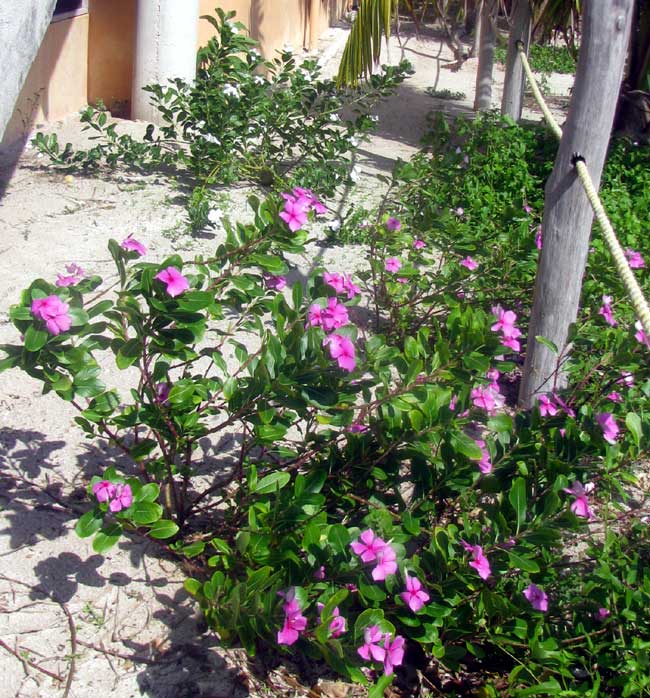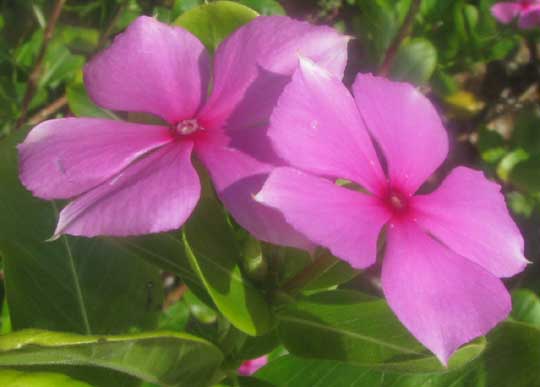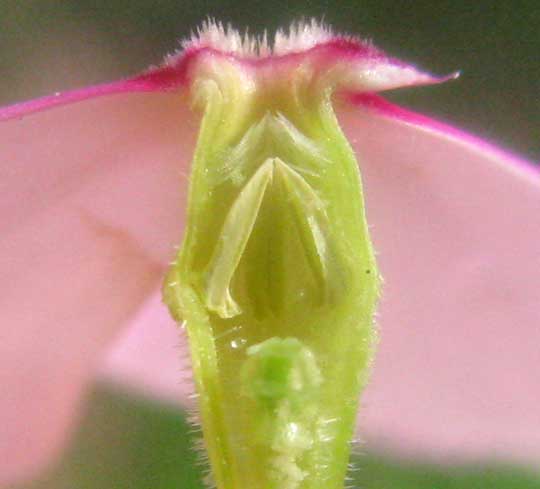Excerpts from Jim Conrad's
Naturalist Newsletter

from the July 17, 2011 Newsletter issued from Mayan Beach Garden Inn 20 kms north of Mahahual; Caribbean coastal beach and mangroves, ~N18.89°, ~W87.64°, Quintana Roo state, MÉXICO
MADAGASCAR PERIWINKLE
In this part of the world there's a certain knee-high, evergreen subshrub with pink to white, five-lobed flowers that you're just as likely to see featured in flower gardens as emerging from cracks in sidewalks or growing as weeds along sandy roadsides. Two unplanted "volunteer" plants beside the resort here, one pink- flowered and the one in the back white, are shown above.
Two phlox-like, 2-½ inch wide (4cm) flowers are shown below:

By "phlox-like" I mean that each blossom's corolla tube is topped by five petal-like lobes that expand out horizontally.
If you make a longitudinal section of the tube, however, you'll discover a very unphlox-like anatomy. What you'll find are pollen-releasing anthers clustering at and almost blocking the tube's mouth, while below the anthers there's a massive, plug-like stigma head atop a long, slender style leading up from the ovary. All this can be seen below:

In other words, this is anatomy we've often seen, for example in the Yellow Oleander, analyzed at www.backyardnature.net/yucatan/y-olean5.jpg.
These leaning-together anthers with short or missing filaments hovering above a pluglike stigma head in a flower with a slender tube atop which petal-like lobes expand outwards is classic anatomy for the big Dogbane Family, the Apocynaceae. Among the most famous species in that family are Oleander, Frangipani, Allamanda and Mandevilla vines, and Periwinkle.
In fact, the ubiquitous, pretty plant in our picture is known as the Madagascar Periwinkle. It's CATHARANTHUS ROSEUS. Older literature calls it Vinca rosea, the genus Vinca being the periwinkles.
Madagascar Periwinkle really is originally from Madagascar, though during my botanist days there when I earnestly looked for it I never saw it in the wild. Now I know that in its native land Madagascar Periwiinkle is an endangered species because of habitat destruction mostly brought about by slash and burn agriculture.
It turns out that Madagascar Periwinkle not only is pretty enough to be planted throughout the world's tropics, and tough enough to live in many relatively inhospitable environments, but also the plant is much used in herbal medicine. In traditional Chinese medicine its extracts have been used for diabetes, malaria, Hodgkin's disease, and more. In the West, Vinblastine and Vincristine extracted from the plant are used in the treatment of leukemia.
In fact, Madagascar Periwinkle has been involved in a certain ongoing international controversy. Western pharmaceutical companies have patented drugs based on compounds in the Madagascar Periwinkle without ever compensating anyone in Madagascar. Thus Malagasies can end up having to pay for medicine that in their own country they can't legally produce using their own plants. This and similar histories have led to accusations of "biopiracy." When I was on expedition in Madagascar, however, the Malagasies monitored very closely what we collected, and made sure they got their part.